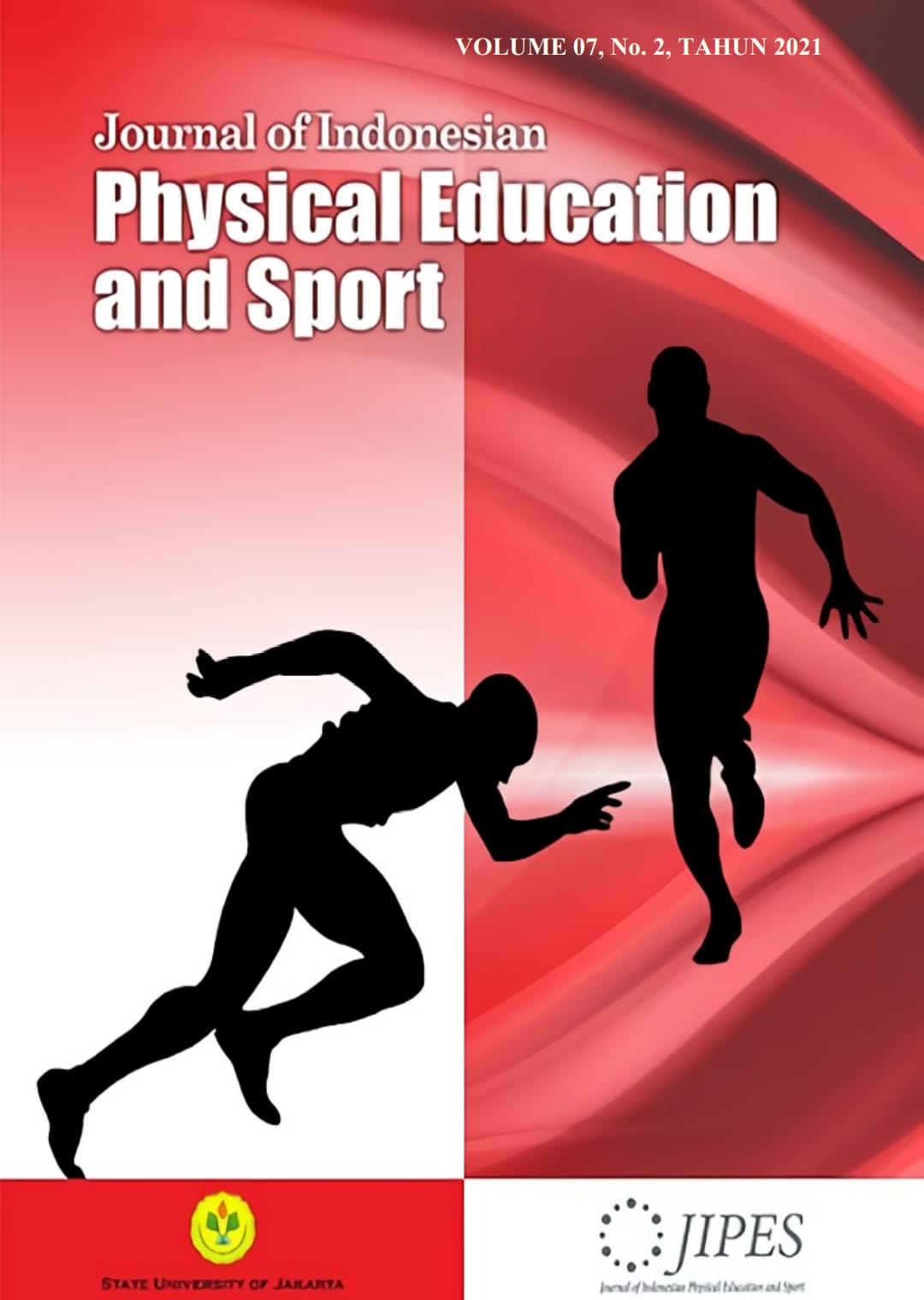The Correlation of Aerobic and Anaerobic Capacities with Performance in Badminton Matches
Aerobic and Anaerobic Capacities
Keywords:
Badminton, Aerobics, Anaerobic, Performance, AchievementAbstract
The purpose of this study was to measure the aerobic and anaerobic capacities of badminton athletes, and to relate them to performances, such as the number of drive shots, lob shots, or smash shots, in badminton matches. 12 badminton athletes in the men's doubles category carried out two types of measurements, namely laboratory test and match test. Laboratory tests included the VO2max test using the Lode Quark Cardio Pulmonary Exercises Test (CPET), as well as a battery test (push-up, back-up, sit-up, and half-squat). Match test was conducted using competition match system. Match performances, such as drive shots, lob shots, or smash shots were analyzed by experts. The higher the VO2max level of the pair of men's doubles athletes, the better its correlation with their badminton strokes was. For example, pair 1 (native 1 and native 2) had a mean VO2max of 54.2 ± 0.9 ml/kg/min and performed the average numbers of lob strokes of 35.5 ± 0.7, drive shots of 47.5 ± 0.7, and smash of 19.5 ± 7.8. The lowest result was found in pair 6, in which the VO2max level was 47.6 ± 0.4. The average numbers of shots performed by this pair were 23.5 ± 2.1 for lob, 29.5 ± 0.7 for drive, and 5.5 ± 0.7 for smash. On the other hand, Pair 1 had the highest average repetition of the battery test compared to the other pairs (Push-up = 35.5 ± 0.7, Back-up = 49.5 ± 0.7, Sit-up = 55.0 ± 0.0, Half-squat = 69.5 ± 0.7), and it was directly proportional to the results of hitting performance in a match. This study shows that there is a correlation between VO2max average and battery test results and the performance of badminton men's doubles athletes.
References
Cabello Manrique, D., & González-Badillo, J. J. (2003). Analysis of the characteristics of competitive badminton. British Journal of Sports Medicine, 37(1), 62–66. https://doi.org/10.1136/bjsm.37.1.62
Couppé, C., Thorborg, K., Hansen, M., Fahlström, M., Bjordal, J. M., Nielsen, D., … Magnusson, S. P. (2014). Shoulder rotational profiles in young healthy elite female and male badminton players. Scandinavian Journal of Medicine and Science in Sports, 24(1), 122–128. https://doi.org/10.1111/j.1600-0838.2012.01480.x
Faccini, P., & Dal Monte, A. (1996). Physiologic demands of badminton match play. American Journal of Sports Medicine, 24(SUPPL.), 64–66. https://doi.org/10.1177/036354659602406s19
Fahlström, M., & Söderman, K. (2007). Decreased shoulder function and pain common in recreational badminton players. Scandinavian Journal of Medicine and Science in Sports, 17(3), 246–251. https://doi.org/10.1111/j.1600-0838.2006.00562.x
Faude, O., Meyer, T., Rosenberger, F., Fries, M., Huber, G., & Kindermann, W. (2007). Physiological characteristics of badminton match play. European Journal of Applied Physiology, 100(4), 479–485. https://doi.org/10.1007/s00421-007-0441-8
Fuchs, M., Faude, O., Wegmann, M., & Meyer, T. (2014). Critical Evaluation of a Badminton-Specific Endurance Test. International Journal of Sports Physiology and Performance, 9, 249–255.
Huang, P., Fu, L., Zhang, Y., Fekete, G., Ren, F., & Gu, Y. (2019). Biomechanical analysis methods to assess professional badminton players’ lunge performance. Journal of Visualized Experiments, 2019(148), 1–8. https://doi.org/10.3791/58842
Lin, W. C., Lee, C. L., & Chang, N. J. (2020). Acute effects of dynamic stretching followed by vibration foam rolling on sports performance of badminton athletes. Journal of Sports Science and Medicine, 19(2), 420–428.
Madsen, C. M., Højlyng, M., & Nybo, L. (2016). Testing of badminton-specific endurance. Journal of Strength and Conditioning Research, 30(9), 2582–2590. https://doi.org/10.1519/JSC.0000000000001350
Marchena-Rodriguez, A., Gijon-Nogueron, G., Cabello-Manrique, D., & Ortega-Avila, A. B. (2020). Incidence of injuries among amateur badminton players: A cross-sectional study. Medicine, 99(18), e19785. https://doi.org/10.1097/MD.0000000000019785
Miller, R., Felton, P. J., Mcerlain-Naylor, S. A., Towler, H., & King, M. A. (2013). Optimum Performance in the Badminton Jump Smash, (1970), 1–7.
Phomsoupha, M., & Laffaye, G. (2015a). The Science of Badminton: Game Characteristics, Anthropometry, Physiology, Visual Fitness and Biomechanics. Sports Medicine, 45(4), 473–495. https://doi.org/10.1007/s40279-014-0287-2
Phomsoupha, M., & Laffaye, G. (2015b). The Science of Badminton: Game Characteristics, Anthropometry, Physiology, Visual Fitness and Biomechanics. Sports Medicine, 45(4), 473–495. https://doi.org/10.1007/s40279-014-0287-2
Ramos Álvarez, J. J., Del Castillo Campos, M. J., Polo Portes, C., Ramón Rey, M., & Bosch Martín, A. (2016). Analisis de parámetros fisiológicos en jugadores juveniles españoles de bádminton. Revista Internacional de Medicina y Ciencias de La Actividad Fisica y Del Deporte, 16(61), 45–54. https://doi.org/10.15366/rimcafd2016.61.004
Rampichini, S., Limonta, E., Pugliese, L., Cè, E., Bisconti, A. V., Gianfelici, A., … Esposito, F. (2018). Heart rate and pulmonary oxygen uptake response in professional badminton players: comparison between on-court game simulation and laboratory exercise testing. European Journal of Applied Physiology, 118(11), 2339–2347. https://doi.org/10.1007/s00421-018-3960-6
Vial, S., Cochrane, J., J. Blazevich, A., & L. Croft, J. (2019). Using the trajectory of the shuttlecock as a measure of performance accuracy in the badminton short serve. International Journal of Sports Science and Coaching, 14(1), 91–96. https://doi.org/10.1177/1747954118812662
Zhang, B., Li, F., & Jiang, W. (2013). Mixed Doubles Match Technical and Tactical Analysis of World Badminton Champion Based on Mathematical Statistics. Advances in Physical Education, 03(04), 154–157. https://doi.org/10.4236/ape.2013.34025










 </a > a
</a > a 